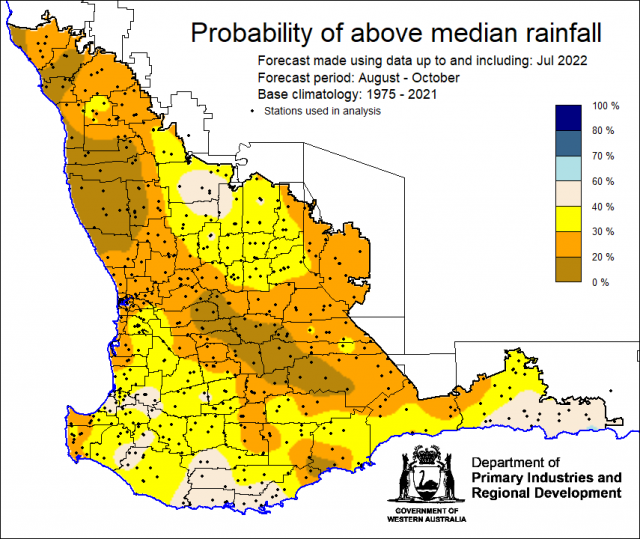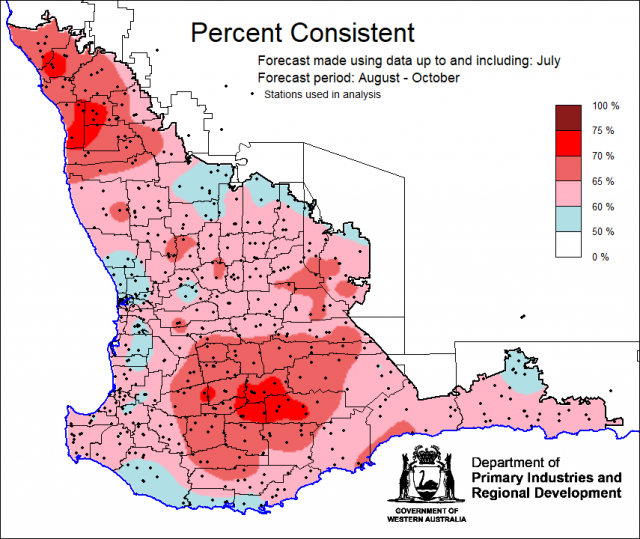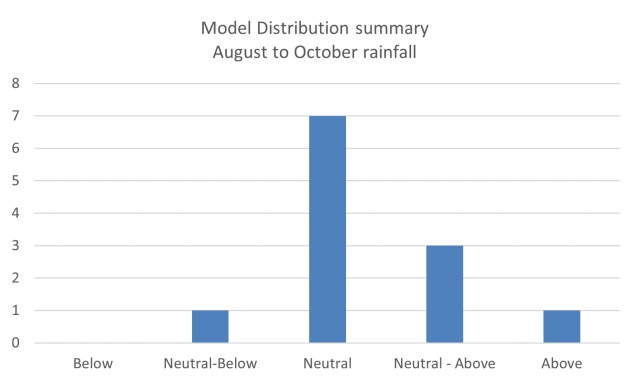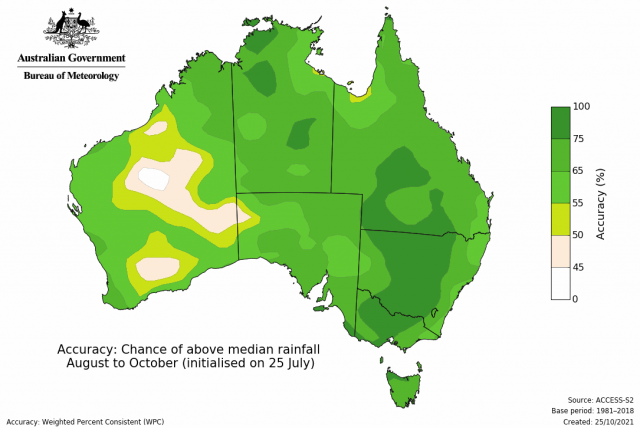Summary
The Department of Primary Industries and Regional Development’s (DPIRD) Statistical Seasonal Forecast (SSF) outlook for August to October, 2022 is indicating less than 40 % probability of above median rainfall for the South West Land Division.
- For August to October, the SSF forecast is indicating less than 40% probability of above median rainfall for the South West Land Division. The most likely decile range map is indicating decile 2-3 for the majority and decile 4-7 for South East Coastal forecast district. Skill is poor to good at 50 to 75 % consistent.
- The Bureau of Meteorology’s seasonal outlook for August to October 2022 is indicating 30-60% chance of exceeding median rainfall for the SWLD. The higher chances (55-65%) are for the South East Coastal Forecast District. Predictive skill is poor to good (45-75% consistent). The current longer-term outlook (at time of writing) for September to November 2022 is neutral (40-65%) chance of exceeding median rainfall with poor to moderate skill (45-65%).
- Temperature outlooks for August to October 2022, from the Bureau indicate a 55-80% chance of above average day-time maxima, with the higher chances along the coast. Skill is 75-100%. For night-time minima for the SWLD, the Bureau is indicating 60- 80% chance of exceeding above average temperatures, with the higher chances along the coast. Skill is poor at 55-75%.
- July rainfall was average to below average for the SWLD. July maximum temperatures were above average, with minimum temperatures average.
- The main climate driver influencing South West Land Division climate is the negative Southern Annular mode, which has brought rain in the first week of August. SAM is however, expected to return to being positive, which will have a drying influence for parts of south-west. The Indian Ocean Dipole (IOD) is currently negative and likely to remain through to November. Past negative IOD events generally increase rainfall in the eastern grainbelt.
Three Month Outlook for the south-west of Western Australia
Statistical Seasonal Forecasting (SSF)
DPIRD’s Statistical Seasonal Forecast (SSF) system uses historical relationships between global sea surface temperature and sea level pressure with rainfall in south-west Australia to produce forecasts of rainfall for the coming months. Users can click on any station indicated on the map for location-specific forecast information from DPIRD’s Seasonal Climate Information pages.
For August to October, the SSF forecast is indicating less than 40% probability of above median rainfall for the South West Land Division. The most likely decile range map is indicating decile 2-3 for the majority and decile 4-7 for South East Coastal forecast district. Skill is poor to good at 50 to 75 % consistent.


Bureau of Meteorology seasonal climate outlook
The Bureau of Meteorology's climate forecast system for monthly and seasonal climate outlooks is the Australian Community Climate Earth-System Simulator – Seasonal (ACCESS–S2). It is a dynamical (physics-based) forecast modelling system and is a collaboration between the Bureau of Meteorology and the UK Meteorological Office.
The Bureau of Meteorology’s seasonal outlook for August to October 2022 is indicating 30-60% chance of exceeding median rainfall for the SWLD. The higher chances (55-65%) are for the South East Coastal Forecast District. Predictive skill is poor to good (45-75% consistent). The current longer-term outlook (at time of writing) for September to November 2022 is neutral (40-65%) chance of exceeding median rainfall with poor to moderate skill (45-65%).
Temperature outlooks for August to October 2022, from the Bureau indicate a 55-80% chance of above average day-time maxima, with the higher chances along the coast. Skill is 75-100%. For night-time minima for the SWLD, the Bureau is indicating 60- 80% chance of exceeding above average temperatures, with the higher chances along the coast. Skill is poor at 55-75%.
Looking at other rainfall forecasting models, the majority of models are indicating neutral chance of exceeding median rainfall for the SWLD for August to October 2022.

Recent climate
July rainfall was below average to average for the SWLD, due to the positive Southern Annular Mode. July maximum temperatures were above average, with minimum temperatures average. Rainfall decile map for 1 April to 7 August 2022 shows decile 8-10 rainfall for South East Coastal, South Coastal and parts of the Great Southern and Central Wheatbelt forecast districts.
In July the atmospheric pressure was slightly higher than normal over the SWLD.
In July, sea surface temperatures were warmer than average around much of the Australian coastline, particularly to the north and west. The sea surface temperature outlook for August to October by the Bureau of Meteorology indicates SSTs are likely to remain warmer than normal around Western Australia and the north and south-east of Australia.
The Indian Ocean Dipole (IOD) is currently negative and likely to remain through to November. Past negative IOD events generally increase rainfall in the eastern grainbelt.
The Southern Annular Mode (SAM), also known as the Antarctic Oscillation (AAO), describes the north–south movement of the westerly wind belt that circles Antarctica, dominating the middle to higher latitudes of the southern hemisphere. SAM is currently negative, but is forecast to return to positive values for the rest of August. A positive SAM has a drying influence for parts of south-west and south-east Australia, while neutral SAM has little influence on Australian rainfall. For more information see the Bureau of Meteorology’s Climate Driver Update.
The El Niño–Southern Oscillation is currently neutral. The Bureau of Meteorology ENSO outlook is a La Niña Watch, as there is around 50% chance of a La Niña reforming later in 2022. Past La Niña’s have had very little influence on the climate of the South West Land Division.
The table below gives a summary of past month and three-month South West Land Division (SWLD) climate conditions, and can indicate what is likely to occur in the near future if climate conditions follow the current pattern.
| Climate Indicator | Past month | Past 3 months |
|---|---|---|
| SWLD Rainfall | Below average to average | Below average to average |
| SWLD Mean Temperature | Above average | Above average |
| SWLD atmospheric pressure | Higher | Lower |
| Indian Ocean Sea surface temperature | Warmer | Warmer |
| El Niño/Southern Oscillation (ENSO) | Neutral | La Niña |
| Indian Ocean Dipole (IOD) | Negative | Neutral |
| Southern Annular Mode (SAM) | Positive | Positive |



